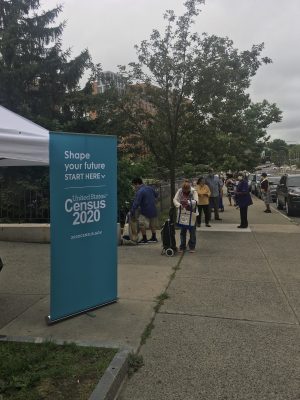Westchester Sees Mixed Results So Far in 2020 Census Initiative
 There is still another three and a half months for anyone who hasn’t responded to the 2020 Census to participate.
There is still another three and a half months for anyone who hasn’t responded to the 2020 Census to participate.
Westchester County, which has run an aggressive public information initiative since last year to advertise the importance of responding to the once-a-decade count, had a 63 percent response rate through July 8, according to the county Planning Department’s regularly updated tallies.
By contrast, New York State stood at 57.5 percent while nationwide it was 62 percent.
“Westchester County is trying very hard to make sure that everyone who legitimately lives here is counted in the Census,” said County Executive George Latimer.
Many municipalities have formed or appointed a Complete Count Committee, consisting of one or more community members whose responsibility is to encourage as many residents to respond.
DaMia Harris-Madden, part of the Village of Pleasantville’s Complete Count Committee, said last week while the overarching goal is to have a 100 percent response rate, most communities would be happy with exceeding their 2010 participation.
Pleasantville’s 72.3 percent response rate now exceeds its 72 percent participation 10 years ago, but most of the county still trails its 2010 numbers as of last week. However, with participation having been extended until Oct. 31, there is still time for communities to get a strong response.
“I feel very confident we’ll be okay,” Harris-Madden said. “I’m more concerned about the communities that are under (the 2010 response rate), and I’m not sure what their communities are doing to engage people to respond. I just think there’s this overarching concern about information.”
Some communities may be more susceptible to being undercounted, she said. Young adults who 10 years ago were dependents in their parents’ home may not be aware they need to respond. Areas where fewer people have computers, whether it’s because it’s poorer community or one with an older population, is another reason.
Communities with a high concentration of immigrants is another population that can be leery of participating.
Harris-Madden said convincing people that information will not be used by authorities is a challenge. The Census is simply to count people.
“This reporting should not trigger any other investigation,” she said. “People still have this impression that will happen if they have someone who may be living in their home helping with their child care. That’s the population that we’re missing.”
Earlier this year, Blanca Lopez, an adviser to Latimer on strategic initiatives for the 2020 Census, explained why the Census is so critical to communities.
“Every person who responds to the Census is contributing to the community,” Lopez said. “Money that comes from the federal government is going towards our county, our communities, our school districts, our state, our first responders, our infrastructure. So we want to make sure people understand how they are contributing and making our communities better.”
Pleasantville is one of seven communities in the county that have now exceeded their 2010 totals. They are joined by North Salem (66.3 percent), Lewisboro (75 percent), Hastings-on-Hudson (76.6 percent), Croton-on-Hudson (76.8 percent), New Castle (77.6 percent) and Pelham Manor (77.8 percent).
The highest participation rate is Scarsdale at 78.7, about 0.3 percent behind their total from 10 years ago.
While another 12 communities are within 2 percent of matching their 2010 responses, there are some communities that are far behind. The worst response rate in the county is Mount Vernon at 49.3 percent. Port Chester is next at 50.3 percent, a whopping 12.3 percent behind its 2010 totals, the largest gap in the county.
Those municipalities are followed by Yonkers, Elmsford, Peekskill, Sleepy Hollow and the Village of Ossining.
The second largest deficit is the Village of Buchanan, which is currently at 68.7 percent participation but more than 10 percent behind 2010.
Harris-Madden said the pandemic has also played a factor in some communities as many households have other concerns. While residents have until Oct. 31 to respond online if they haven’t already, there will be counters who will start going door to door on Aug. 11.
“I don’t now if we’re going to be successful with that kind of outreach,” Harris-Madden said. “People are not going to want to stand there and talk to someone at this time because of the virus.”
For those who haven’t responded and still have the card they received in the mail earlier this year, visit www.my2020census.gov. For more information or receive help, call 844-330-2020.

Martin has more than 30 years experience covering local news in Westchester and Putnam counties, including a frequent focus on zoning and planning issues. He has been editor-in-chief of The Examiner since its inception in 2007. Read more from Martin’s editor-author bio here. Read Martin’s archived work here: https://www.theexaminernews.com/author/martin-wilbur2007/
